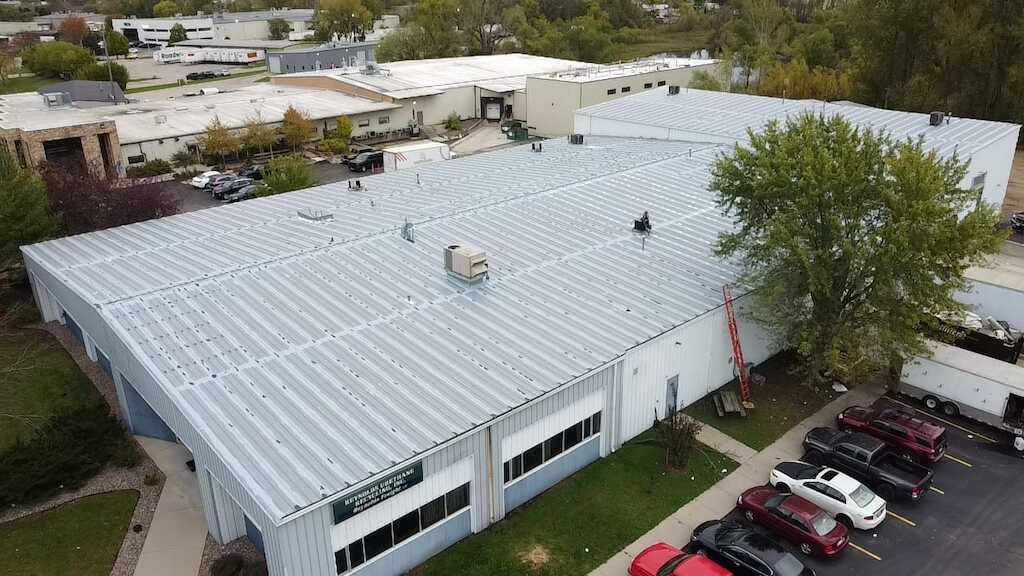This guide will help you understand the exact commercial roof replacement timeline based on these factors. That way, you can determine the best time to schedule repairs.
How Long Does It Take to Replace a Roof?
It takes anywhere from a few days to over a month to replace a commercial roof, depending on the following factors:
- Material: It takes less time to replace a metal or membrane roof than a tar and gravel roof
- Roof design: It takes less time to install flat roofs or low-pitched roofs than high-pitched or peaked roofs
- Roof size: It takes more time to replace larger roofs than smaller ones
- Repair needs: It takes more time to replace roofs with leaks or structural damage to the sub roofing
- Weather: It takes less time to replace a roof during fair weather than under adverse weather conditions
Below, we break down average replacement timelines for each of the most common types of commercial roofs.
How Long Does It Take to Replace a Metal Roof?
Metal roofs take around 12 days to replace under optimal conditions. By that, we mean that the roof is flat or low-pitched and average in size and in good condition. Also, weather conditions must be advantageous.
A metal roof with a high slope can double this timeline. One of the reasons for this is that contractors must install new gables to support the roof.
Larger-sized roofs (e.g., roofs measuring over 10,000 square feet) can also significantly increase the replacement timeline. It will take contractors more time to tear up the old roof and then install the new one.
Needing repairs before contractors can replace the roof will also slow down the timeline. For example, the substrates may need replacing, or contractors may need to address water damage.
The most common reason for roof replacement delays is rain. Contractors cannot work in rainy conditions. Every day it rains, you will have to add another day to your overall timeline.
How Long Does It Take to Replace a Membrane Roof?
Membrane roofs take anywhere from one week to a month to replace. Even though most membrane roofs are flat, they are some of the most difficult to replace since the materials are fragile. Also, it takes more skill to install them.
The exact amount of time also depends on the material. Most membrane roofs consist of one of the following materials:
- EPDM
- TPO
- PVC
TPO membranes typically take the least amount of time to install. In fact, many contractors can install TPO membranes even faster than metal and other common types of commercial roofing.
EPDM membranes generally take the longest to install of the three. PVC roofing falls somewhere in between.
How Long Does It Take to Replace a Tar and Gravel Roof?
Tar and gravel roofs (also known as built-up roofs) can take more than a month to replace.
Removing old tar and gravel roofing is a labor-intensive process. Contractors must scrape away the gravel, then the 3–6 layers of asphalt, tar, and felt beneath.
Installing a new tar and gravel roof takes even longer. It is much easier to replace one of these roofs with another material like metal, EPDM, TPO, or PVC.
How Do You Know If You Need Commercial Roof Repairs or Replacement?
You know if you need commercial roof repair or replacement if you see leaks or weather damage. Roofing materials only last a few decades, too, so you may need to replace your roof when it starts showing signs of age.
Leaks
Leaks are the #1 reason commercial buildings get roof repairs or replacements. And considering the amount of damage moisture can do to your building and equipment, this fact should be no wonder.
Even the smallest leaks can cause a ton of damage if left untreated. Getting a roof repair now can save you money in the long run. You may be able to put off a full replacement.
Weather Damage
Wisconsin may not be the rainiest or snowiest state, but it does get a ton of tornadoes. Our state averages a whopping 23 tornadoes per year. And the high winds characteristic of these natural disasters can wreak havoc on your roof.
Additionally, even the most durable roofs can become victims of water damage under the right conditions. For example, say your downspouts get clogged. Water can accumulate on your roof, eventually causing damage.
Age
Unfortunately, we have yet to discover a roofing material that lasts forever. Well-maintained commercial roofing systems can last anywhere from 10 to 60+ years (more on this in a moment).
But after that point, you will need a full roof replacement. Weathering, UV rays, and natural wear-and-tear can all decrease the effectiveness of your roof over time. And eventually, piecemeal repairs will no longer be enough.
What Are the Signs of a Leaky Commercial Roof?
The signs of a leaky commercial roof include rusting, musty smells, and visible water damage. Yet, these signs do not always appear until the leak has progressed significantly.
Recognizing the early signs of a roof leak can help you avoid the potential consequences of moisture build-up on and beneath your roof.
Early Signs of a Roof Leak
The earliest signs of a roof leak include cracked roofing material, missing roofing material, and water spots on the roof decking.
If you do not fix the damage ASAP, you may also start to see water spots on interior ceilings and walls.
Consequences of Not Fixing Roof Leaks
You may think a small commercial roof leak is no big deal. However, consider the following consequences of putting off leaky roof repairs:
- Structural damage
- Electrical wiring hazards
- Mold and mildew growth
These problems are not even to mention the potential for damage to your building and equipment. Potential fire hazards and mold problems can also lead to employee health problems and put you at risk of legal trouble.
Why Is Repair Required After Storm Damage?
Your commercial roof may require repair or replacement after a storm due to the damage high winds and heavy rain can cause. But roof damage is not the only thing to worry about after a storm.
Below, we discuss three other reasons to consider roof repair or replacement services after bad weather strikes.
You Could Void Your Warranty
Did you know that you could void your roof warranty if you do not maintain your roof? Part of regular maintenance is repairing portions of the roof that get damaged during bad weather.
Unfortunately, most roofing warranties do not cover the cost of repairs for “acts of God.” That phrase usually refers to natural disasters like hurricanes, storms, and earthquakes.
Still, your business insurance policy may cover some of the cost of repairs. Even if they do not, covering the cost out-of-pocket is more than worth it to keep your warranty intact.
Storms Can Cause Leaks
Catching roof leaks early can help you avoid costly consequences and potentially even save lives. That is why you should always inspect your roof after a storm. Storms are among the top causes of roof damage and leaks.
Signs to look out for include damaged or missing flashing, curling shingles, damaged pipe boots or vents, or cracks in the chimney. Of course, visible sagging and pools of water are also bad signs.
If you see any of these signs of damage, a leak could be coming soon. Contact a local roofing contractor to repair the damage and prevent the consequences of moisture build-up in your roof.
Structural Damage
Storms don’t just cause leaks. They can also damage the structure of your building. These issues are far more serious and require immediate attention, especially if they make your building uninhabitable.
Look out for cracks or bulges, significant soil shrinkage, gaps around windows and doors, saggy or sloping floors, or a crumbling facade. These problems are not something to ignore, so call a roofing contractor ASAP.
How Long Does a Commercial Roof Last?
Roofs can last anywhere from 10 to 100 years, depending on the material. A roof’s lifetime also depends on how well you maintain it. Getting regular inspections and repairs is part of the maintenance process.
Have you decided to replace your commercial roof? If so, you may wonder which roofing material is most durable and lasts the longest.
How Long Does a Metal Roof Last?
The average metal roof lasts 40–70 years. The exact lifetime depends on the metal type and how well you maintain it.
For example, copper and zinc roofing tends to last the longest. Some copper and zinc roofs can last more than 100 years when cared for properly. At the low end, copper and zinc last 80 and 60 years, respectively.
Steel roofs tend to have the shortest lifetime of the different metal types. Expect a commercial steel roof to last up to 50 years. Aluminum falls somewhere in between, with a typical lifespan of 40–60 years.
How Long Does a Membrane Roof Last?
Membrane roofs last anywhere from 10 years to 50 years or more, depending on the material. Here is a breakdown of how long you can expect your membrane roof to last by material type:
- EPDM: 50+ years
- TPO: 10–30 years
- PVC: 15–30 years
A big factor in the longevity of membrane roofs is installation. It is crucial to work with an experienced commercial roofing company to get the most out of your membrane roof.
How Long Does a Tar and Gravel Roof Last?
A tar and gravel roof lasts 20–40 years on average. As with membrane roofing, built-up roofs have to be installed and maintained properly to maximize their lifespans.
Looking for Commercial Roofing Services in Wisconsin?
How long does it take to replace a roof? It takes a week to over a month to remove an old commercial roof and install a new one. Putting in a new metal roof can ensure you won’t have to replace it again in your lifetime.
Are you searching for commercial roofing services in the Madison, WI area? Yutzy Roofing Service has a solution for all your commercial roofing needs. Contact Yutzy today to get a quote for your roofing repair or replacement.

